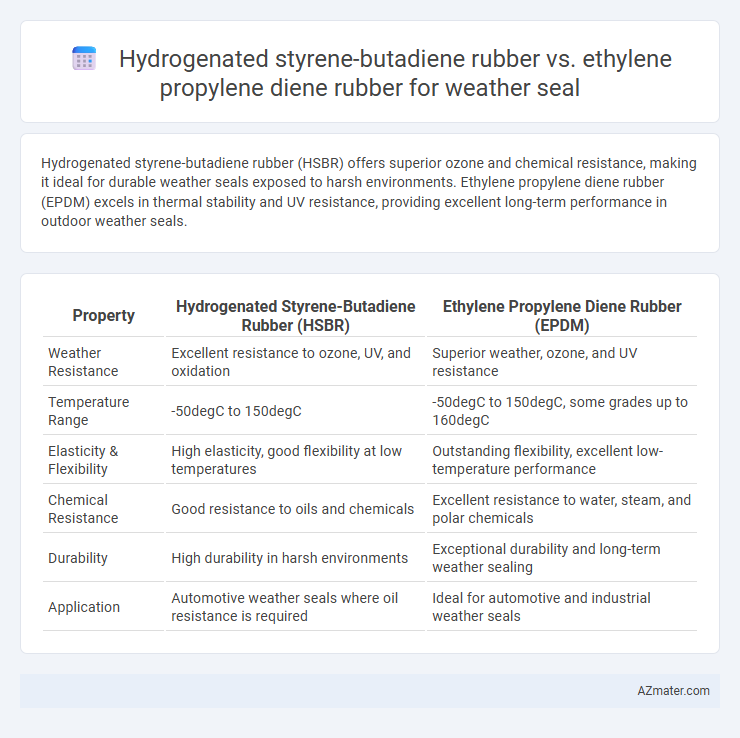Hydrogenated styrene-butadiene rubber (HSBR) offers superior ozone and chemical resistance, making it ideal for durable weather seals exposed to harsh environments. Ethylene propylene diene rubber (EPDM) excels in thermal stability and UV resistance, providing excellent long-term performance in outdoor weather seals.
Table of Comparison
| Property | Hydrogenated Styrene-Butadiene Rubber (HSBR) | Ethylene Propylene Diene Rubber (EPDM) |
|---|---|---|
| Weather Resistance | Excellent resistance to ozone, UV, and oxidation | Superior weather, ozone, and UV resistance |
| Temperature Range | -50degC to 150degC | -50degC to 150degC, some grades up to 160degC |
| Elasticity & Flexibility | High elasticity, good flexibility at low temperatures | Outstanding flexibility, excellent low-temperature performance |
| Chemical Resistance | Good resistance to oils and chemicals | Excellent resistance to water, steam, and polar chemicals |
| Durability | High durability in harsh environments | Exceptional durability and long-term weather sealing |
| Application | Automotive weather seals where oil resistance is required | Ideal for automotive and industrial weather seals |
Introduction to Weather Seals: Importance of Material Choice
Hydrogenated styrene-butadiene rubber (HSBR) offers superior resistance to ozone, heat, and aging, making it ideal for weather seals exposed to harsh environmental conditions. Ethylene propylene diene rubber (EPDM) provides excellent flexibility, UV resistance, and water resistance, which are critical for maintaining effective weather seals in both automotive and architectural applications. Selecting the appropriate material directly impacts the durability, sealing performance, and longevity of weather seals in varying climates.
Overview of Hydrogenated Styrene-Butadiene Rubber (HSBR)
Hydrogenated Styrene-Butadiene Rubber (HSBR) exhibits superior resistance to ozone, heat, and chemical degradation, making it an excellent choice for weather seals exposed to harsh environmental conditions. Its hydrogenation process enhances the polymer's saturation, significantly improving weatherability and durability compared to non-hydrogenated variants. HSBR offers enhanced mechanical strength and flexibility, providing long-lasting sealing performance in automotive and industrial weather-resistant applications.
Overview of Ethylene Propylene Diene Rubber (EPDM)
Ethylene Propylene Diene Monomer (EPDM) rubber exhibits exceptional resistance to weathering, ozone, UV radiation, and temperature extremes, making it ideal for weather seal applications. Its molecular structure provides superior elasticity and durability compared to hydrogenated styrene-butadiene rubber (HSBR), ensuring long-term performance in outdoor environments. EPDM's excellent chemical resistance and low permeability to gases make it a preferred choice for sealing against environmental elements in automotive and construction industries.
Comparative Weather Resistance: HSBR vs EPDM
Hydrogenated styrene-butadiene rubber (HSBR) offers superior ozone and heat resistance compared to standard styrene-butadiene, enhancing its durability in weather seal applications. Ethylene propylene diene rubber (EPDM) exhibits exceptional resistance to UV radiation, ozone, and extreme temperatures, making it a preferred choice for outdoor sealing. While HSBR provides better chemical resistance, EPDM generally outperforms HSBR in long-term weather resistance and flexibility under fluctuating climatic conditions.
Ozone and UV Stability in Weather Seals
Hydrogenated styrene-butadiene rubber (HSBR) offers superior ozone and UV resistance compared to conventional styrene-butadiene rubber, making it effective for weather seals exposed to harsh environmental conditions. Ethylene propylene diene rubber (EPDM) demonstrates exceptional ozone and UV stability due to its saturated backbone and diene content, providing long-term durability in weather seals. EPDM is often preferred for weather seals requiring robust resistance to oxidative aging, while HSBR excels in applications demanding a balance of mechanical properties and weathering resistance.
Flexibility and Elasticity Under Varying Temperatures
Hydrogenated styrene-butadiene rubber (HSBR) exhibits superior flexibility and elasticity at low temperatures due to its saturated polymer backbone, which enhances resistance to thermal degradation and ozone exposure. Ethylene propylene diene rubber (EPDM) maintains excellent elasticity across a broad temperature range, particularly excelling in high temperature stability and UV resistance, making it ideal for long-term outdoor weather seals. The selection between HSBR and EPDM depends on specific environmental conditions, with HSBR favored for dynamic flexibility at colder climates and EPDM for sustained elastic performance under prolonged heat and weathering.
Chemical and Environmental Resistance Properties
Hydrogenated styrene-butadiene rubber (HSBR) offers superior chemical resistance to oils, fuels, and oxidation due to its saturated polymer backbone, making it highly durable in harsh weather seal applications. Ethylene propylene diene monomer (EPDM) excels in resistance to ozone, UV rays, and steam, providing exceptional environmental stability for outdoor sealing. HSBR's enhanced hydrocarbon resistance contrasts with EPDM's superior performance against polar solvents and extreme weather conditions, influencing material selection based on specific environmental exposure.
Longevity and Maintenance Requirements
Hydrogenated styrene-butadiene rubber (HSBR) offers superior resistance to ozone, heat, and aging, resulting in longer longevity for weather seals compared to ethylene propylene diene rubber (EPDM). HSBR maintains its mechanical properties under prolonged UV exposure and oxidative environments, reducing the frequency of replacement or repairs. In contrast, EPDM requires more frequent maintenance due to its lower resistance to hydrocarbons and thermal degradation, impacting overall durability in harsh weather sealing applications.
Cost-Effectiveness and Manufacturing Considerations
Hydrogenated styrene-butadiene rubber (HSBR) offers superior weather resistance and durability compared to ethylene propylene diene rubber (EPDM), but typically comes with higher raw material costs, impacting overall cost-effectiveness in large-scale weather seal production. EPDM provides excellent cost-efficiency due to lower material expenses and simpler processing methods, making it a preferred choice for weather seals requiring good weatherability with tight budget constraints. Manufacturing considerations include HSBR's compatibility with specialized curing processes and higher temperature resistance, while EPDM benefits from easier extrusion and molding, reducing cycle times and tooling costs.
Application Suitability: Which Rubber is Better for Weather Seals?
Hydrogenated styrene-butadiene rubber (HSBR) offers superior ozone and heat resistance, making it highly suitable for weather seals subjected to harsh climatic conditions and prolonged UV exposure. Ethylene propylene diene rubber (EPDM) excels in resistance to water, steam, and a broad range of chemicals, providing excellent durability in moist or chemically aggressive environments. For weather seal applications requiring optimal longevity against weathering, HSBR is generally preferred due to its enhanced aging resistance, while EPDM remains a preferred choice where moisture and chemical exposure dominate.

Infographic: Hydrogenated styrene-butadiene rubber vs Ethylene propylene diene rubber for Weather seal
 azmater.com
azmater.com